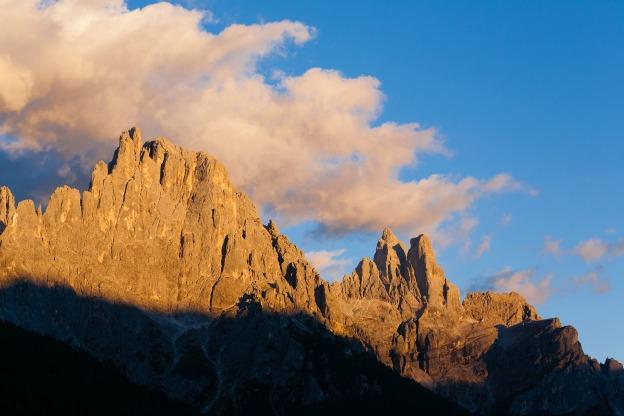Enrosadira: The Magic of the Dolomites at Sunrise and Sunset
ITA:

Enrosadira is the term given to the phenomenon by which most of the peaks in the Dolomites, at dawn and dusk, take on a pink/reddish color, which gradually turns into violet.
The reason behind the changing colors is due to the calcium carbonate and magnesium carbonate of the dolomite, the mineral found in large quantities in the rocky walls of the Dolomites. At sunrise and sunset, the rocky cliffs take on hues that vary from light yellow to bright red, to different shades of pink and violet, until the mountains disappear in the dark of night.
Enrosadira is a ladin term literally meaning “turning pink” (ladin is the ancient language of the inhabitants of the Dolomites).
Enrosadira can vary greatly depending on the time of the year, and even from one day to the next. This is due to the different position of the sun throughout the year and to atmospheric conditions.
The Rosengarten group in the Fassa Valley of Trentino-Alto Adige is especially famous for the pink shade it takes on at sunset and sunrise. You can best admire it from Pozza di Fassa, located in an area popular with outdoors lovers both in winter and summer.
Other spectacular viewpoints from where to admire the enrosadira are:
From Alpe di Siusi/Seiser Alm, the largest high altitude Alpine meadow in Europe, looking at Sciliar and Sassolungo; from Campitello di Fassa, looking at Sass Pordoi; from Passo Rolle, looking at Cimon della Pala; from Val di Landro, looking at the Tre Cime di Lavaredo; from San Martino di Castrozza, looking at Pale di San Martino.
Enrosadira è il nome dato al fenomeno per cui la maggior parte delle cime delle Dolomiti, all'alba e al tramonto, assumono un colore rosa / rossastro, che si trasforma gradualmente in viola.
Il motivo dei colori cangianti è dovuto al carbonato di calcio e di magnesio della dolomite, il minerale che si trova in grande quantità nelle pareti rocciose delle Dolomiti. All'alba e al tramonto, le pareti rocciose assumono tonalità che variano dal giallo chiaro al rosso vivo, a diverse colorazioni di rosa e di viola, fino a quando le montagne scompaiono nel buio della notte.
Enrosadira è un termine ladino che significa letteralmente "diventare rosa" (il ladino è l’antica lingua degli abitanti delle Dolomiti).
L’enrosadira può variare notevolmente a seconda del periodo dell'anno, e anche da un giorno all'altro. Ciò è dovuto alla diversa posizione del sole durante l'anno e alle condizioni atmosferiche.
Il gruppo del Catinaccio in Val di Fassa in Trentino-Alto Adige è specialmente famoso per le tonalità rosa che assume al tramonto e all'alba. È possibile ammirarlo da Pozza di Fassa, che si trova in una zona molto frequentata dagli amanti delle attività all'aria aperta, sia in inverno che in estate.
Altri punti di vista spettacolari da cui ammirare l'enrosadira sono:
Dall’Alpe di Siusi, il più grande alpeggio d'alta quota in Europa, si osservano lo Sciliar e il Sassolungo; da Campitello di Fassa, si ammira il Sass Pordoi; dal Passo Rolle, si guarda Cimon della Pala; dalla Val di Landro, le Tre Cime di Lavaredo; da San Martino di Castrozza, le Pale di San Martino.











